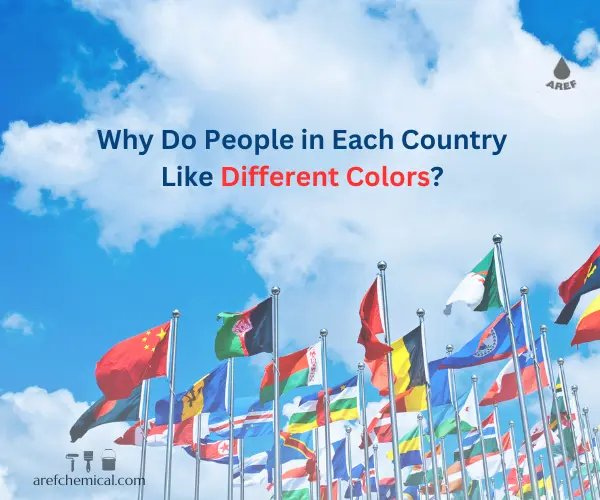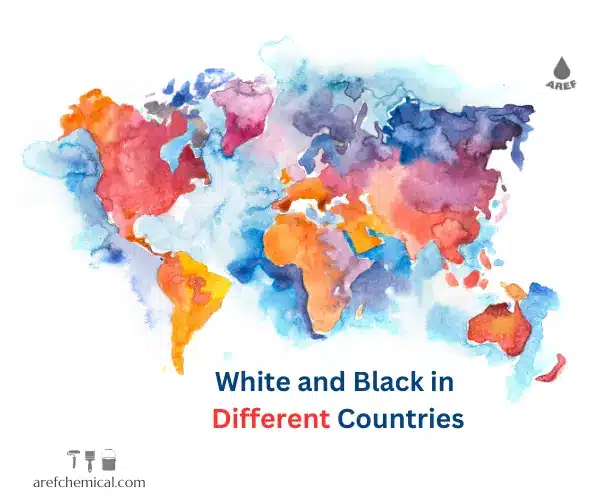Colors not only have aesthetic aspects, but also play an important role in human culture and communication. They are also an integral part of our daily lives and have profound effects on emotions, behaviors and cultures. Each color, especially in different contexts, has a specific meaning in different countries. Of course, it represents certain emotions, values and beliefs in a culture. The concept of color in different countries can be extremely different and is formed based on the history, religion and social traditions of each country. In this article, we will examine the concept of color in different countries and their cultural influences.
Why do people in each country like different colors?
Colors are liked by people in each country for different reasons. So the concept of color in different countries. These reasons can be cultural, historical, religious, geographical, and even psychological. Here are a few of these reasons:
1. Cultural and historical influences
History and traditions: The history and traditions of each country play an important role in determining the colors people like. For example, in China, the color red is very popular due to its historical connection with important celebrations and ceremonies such as Chinese New Year and weddings.
Symbols and myths: Many colors are associated with specific symbols and myths in different cultures. For example, in Western culture, the color white symbolizes purity and innocence, while in Eastern cultures such as China and Japan, this color is associated with death and mourning.
2. Religious influences
Religion and beliefs: Religion and religious beliefs also play an important role in people’s color preferences. In Islamic countries, green is very popular as a symbol of heaven and the religion of Islam. In India, saffron is considered to be a color of interest due to its association with Hinduism and Buddhism.
3. Geographical and Environmental Influences
Climate Conditions: The climate and environmental conditions of each region can also affect people’s color preferences. For example, in tropical regions, light and cool colors such as blue and green are more popular, as these colors evoke a sense of coolness and tranquility.
Nature and Landscapes: The natural landscapes and dominant colors in the nature of each region can also affect people’s color preferences. In areas with green and forested landscapes, green may be more popular.
4. Psychological Influences
Feelings and Emotions: Colors can evoke different feelings and emotions in people. For example, blue can evoke feelings of calm and trust, while red can evoke feelings of energy and enthusiasm. These psychological effects can influence people’s color preferences.
Personal Experiences: Each person’s personal experiences can also influence their color preferences. For example, a person who has had a positive experience with a certain color may like that color more.
5. Social and Economic Influences
Fashion and Social Trends: Fashion and social trends can also influence people’s color preferences. For example, different colors have been popular in fashion and interior design during different historical periods.
Advertising and Media: Advertising and media also play an important role in shaping people’s color preferences. The colors used in advertising and media can have a great impact on a society’s color preferences.
People’s color preferences in each country are formed for several reasons, including cultural, historical, religious, geographical, psychological, social, and economic influences. Awareness of these factors can help to better understand color preferences in different cultures and be more effective in cross-cultural interactions.
Red
As an essential element in different cultures and societies, colors have different meanings and symbols. In this article, we will examine the concept of color in different countries and their cultural influences.
In many cultures, the color red symbolizes love and excitement. For example, in Western culture, red is known as the color of Valentine’s Day. This color is used on Valentine’s Day and romantic occasions. In China, this color symbolizes happiness and luck is widely used in weddings and Chinese New Year celebrations, and is known as the color that drives away evil. However, in some other countries, red may mean danger or warning, such as its use in traffic signs. In India, red symbolizes happiness and love. At weddings, brides usually wear red dresses.
Blue
The color blue is known in many cultures as a symbol of tranquility and peace. In Indian culture, blue is the color of God Krishna and represents love and affection. In Western countries, blue is usually considered a masculine color. However, in some African cultures, blue may be associated with sadness and grief.
In ancient Egypt, blue was considered the color of the sky and water and symbolized life and fertility. In Persian culture, blue inspires spiritual identity and tranquility and is abundantly seen in Islamic art and architecture. In some cultures, blue symbolizes maturity and self-confidence.
Egypt: In ancient Egyptian culture, blue symbolized life, water, and fertility. It was also associated with God and divine power and was used abundantly in the art and architecture of the time.
Africa: In some African cultures, blue refers to tranquility and peace. In special ceremonies, this color is used as a symbol of hope and a bright future.
West: In Western cultures, blue symbolizes calm, trust, and loyalty. This color is commonly used in business and formal settings.
Yellow
Yellow is known as a symbol of happiness and joy in many cultures. In Western countries, yellow is considered the color of the sun and positive energy. However, in some Asian countries, yellow can mean betrayal or deception. For example, in some Arabic cultures, yellow is considered an unfavorable color.
Japan: In Japan, yellow symbolizes courage, prosperity, happiness, and loyalty. This color is seen in military flags and special ceremonies. It is used in special celebrations and ceremonies and is known as the color that brings happiness.
Mexico: Yellow in Mexico symbolizes happiness and joy and is widely used in festival ceremonies.
Germany: In German culture, yellow means happiness and hope. This color is used in design and decoration and is known as a symbol of brightness and joy.
China: In Chinese culture, yellow symbolizes power and empire. This color was used as the color of emperors’ clothes in the past.
West: In Western countries, yellow symbolizes happiness and energy. This color is usually used in advertising and happy environments.
Green
Green is known as a symbol of nature and life. In Iran, green is a sacred color and a symbol of heaven. In some Islamic countries, green is the color of the Prophet Muhammad (PBUH) and is considered a sacred color. However, in some Western countries, green may be associated with jealousy and sadness.
Islam: Green is known in Islamic culture as the color of heaven and a symbol of life, blessing, and hope. This color is used as a symbol of the religion of Islam and the Prophet Muhammad (PBUH).
Ireland: In Ireland, green is considered a national symbol and a symbol of the shamrock, which represents national identity. In Irish culture, green symbolizes happiness and good luck. This color is especially used in the celebration of St. Patrick’s Day.
East Asia: In some countries, green is considered a symbol of fertility and growth.
Iran: In Iranian culture, green symbolizes life, fertility, and nature. This color is especially used in religious ceremonies and celebrations and is known as a sacred color.
The concept of colors in different cultures of the world is very diverse and complex. These differences reflect the profound influences of history, religion, and cultural traditions on human perception of colors. Awareness of these differences can help us better understand different cultures and interact more effectively with people from different cultural backgrounds.
Black
Black is commonly associated with death and grief in many cultures. In Western cultures, black is used in mourning ceremonies. However, in some African cultures, black may be seen as a symbol of strength and courage.
West: In Western cultures, black is commonly associated with death, mourning, sadness, and grief. Black clothing is commonly worn at funerals and mourning ceremonies and is seen as a symbol of loss.
Africa: In some African cultures, black symbolizes power and wealth. It is used in clothing and jewelry and is seen as a symbol of respect and prestige. Some African cultures see black as a symbol of maturity and responsibility. In some tribes, black is also a symbol of life and fertility.
White
Colors have different meanings and concepts in different cultures around the world. These differences are due to the history, religion, traditions and cultural beliefs of each society.
West: In many Western countries, white symbolizes purity, innocence and peace. This color is commonly used at weddings, and brides wear white to symbolize purity and a new beginning. It is also known as a symbol of love and unity.
East Asia: In countries such as China and Japan, white symbolizes death and mourning. At funerals, people wear white clothes to show their respect for the deceased.
Purple
Purple is a special and attractive color that has different meanings in different cultures and societies. It is often associated with more complex concepts such as spirituality, royalty, and creativity. Purple can also mean durability and stability, especially in the field of economics and business.
Thailand: In Thailand, purple symbolizes mourning and mourning. It is commonly used in funerals.
West: In many Western countries, purple is known as the color of royalty and power. It was historically a color used only by nobility and royalty, especially during the Renaissance and ancient Roman periods. In some Christian cultures, purple is the color of seasons of fasting and penance, including Advent and Lent (the second season of the church calendar).
India: Purple is considered a spiritual color, associated with spirituality and deep contemplation. This color is a symbol of purity and inspiration in religious ceremonies and festivals, especially in Hindu rituals. In Indian culture, purple is also known as the color of creativity and originality, and can express deep desires and wishes.
China: Purple is considered a luxurious color. This color is often used in fashion and decorative arts.
Middle East: In some Middle East countries, purple is a popular color in interior decoration and fashion. This color is known as a symbol of beauty and charm.
Colors have different meanings and symbols in different cultures and have profound effects on people’s daily lives, rituals, and beliefs. Understanding these differences can help us better communicate with other cultures and enjoy the beauty of cultural diversity. Colors not only represent emotions and values, but can also act as a universal language in cross-cultural communication.
Conclusion
The concept of color in different countries varies significantly across countries and is influenced by cultural, historical, and social factors. Understanding these differences can help us better communicate with other cultures and gain a deeper understanding of human emotions and behavior. In general, colors not only add visual beauty to our lives, but also carry deeper messages and meanings that are interpreted differently in different cultures.







25 Responses
In many Western countries, white symbolizes purity and innocence and is used in wedding ceremonies.
But in some Asian countries, such as China and Japan, white is associated with death and mourning.
In many cultures, black symbolizes death and mourning. For example, in Western culture, funerals are usually held in black clothing.
In China, red represents good luck and happiness and is used extensively at celebrations and weddings.
Yellow is a symbol of happiness and good fortune in many cultures. In India, yellow holds a special place in religious celebrations and ceremonies.
Green is the symbol of nature and life in my mind.
Red symbolizes happiness and luck in China and is used in important celebrations and ceremonies such as Chinese New Year.
You’re absolutely right! The color black carries diverse meanings across various cultures. In Western contexts, it often represents mourning, loss, and sorrow, which is why it’s commonly worn at funerals.
Conversely, in several African cultures, black can symbolize resilience, maturity, and the strength that comes from experience. It may also represent the richness of life and the ancestral connection. For instance, in some traditions, black attire is worn during celebrations to honor the spirits of ancestors, merging the themes of life, death, and strength.
This duality highlights how cultural interpretations of colors can vary dramatically, shaping our understanding of life and mortality.
The concept of color varies significantly across different cultures and countries, often carrying unique meanings, associations, and emotional responses.
China: Symbolizes good fortune, joy, and prosperity. It’s commonly used in celebrations, especially during the Lunar New Year.
India: Represents purity and is often worn by brides. However, it can also denote danger in certain contexts.
Middle East: Represents protection and is often used in amulets to ward off evil.
Islamic cultures: Green represents paradise and is often associated with nature and fertility.
The concept of color varies widely across different cultures and countries, influencing art, traditions, language, and social practices.
China: Symbolizes good fortune, happiness, and celebration. It is prominently featured in festivals, weddings, and other joyous occasions.
Western cultures: Commonly associated with love, passion, and danger. It can evoke strong emotional responses.
India: White is worn by mourners and signifies death. However, it is also associated with peace and truth in different contexts.
Western cultures: Often associated with mourning, death, and formality. However, it can also symbolize elegance and sophistication (e.g., black tie events).
Black is usually associated with death
In African cultures black is a symbol of maturity. In tribes, black is a symbol of life.
Green is my favorit
Thank a miilion
https://qomtamirat.com/
Thanks for the information.